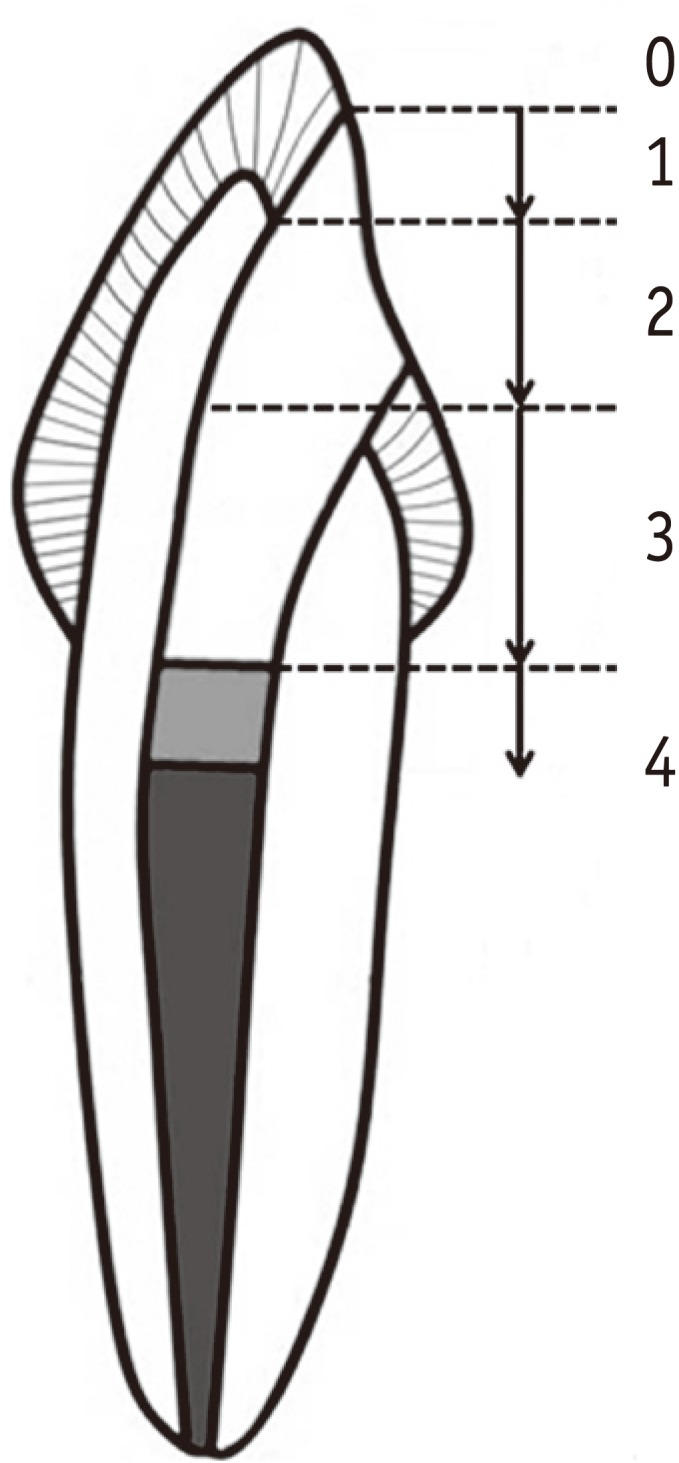Restor Dent Endod.
2013 Feb;38(1):43-47. 10.5395/rde.2013.38.1.43.
Effective application duration of sodium ascorbate antioxidant in reducing microleakage of bonded composite restoration in intracoronally-bleached teeth
- Affiliations
-
- 1Department of Conservative Dentistry, Kyungpook National University School of Dentistry, Daegu, Korea. wisekim@knu.ac.kr
- 2Department of Dental Biomaterials, Kyungpook National University School of Dentistry, Daegu, Korea.
- KMID: 1995476
- DOI: http://doi.org/10.5395/rde.2013.38.1.43
Abstract
OBJECTIVES
The aim of this study was to determine an appropriate application duration of sodium ascorbate (SA) antioxidant gel in reducing microleakage of bonded composite restoration in intracoronally-bleached teeth.
MATERIALS AND METHODS
Eighty endodontically-treated human incisors were randomly divided into eight groups: control, no bleaching; IB and DB, immediate and delayed bonding after bleaching, respectively; S10m, S60m, S24h, S3d and S7d, bleaching + SA gel for 10 min, 60 min, 24 hr, 3 day and 7 day, respectively. For bleaching, a mixture of 30% hydrogen peroxide and sodium perborate was applied for 7 day. All access cavities were restored using One-Step adhesive (Bisco Inc.) and then Aelite LS Packable composite (Bisco Inc.). The bonded specimens were subjected to 500 thermal cycles, immersed in 1% methylene blue for 8 hr, and longitudinally sectioned. Microleakage was assessed with a 0 - 4 scoring system and analyzed using nonparametric statistical methods (alpha = 0.05).
RESULTS
Group IB showed a significantly higher microleakge than the control group (p = 0.006) and group DB a statistically similar score to the control group (p > 0.999). Although groups S10m, S60m, and S24h exhibited significantly higher scores than group DB (p < 0.05), the microleakage in groups S3d and S7d was statistically similar to that in group DB (p = 0.771, p > 0.999).
CONCLUSIONS
Application of SA gel for 3 day after nonvital bleaching was effective in reducing microleakage of composite restoration in intracoronally-bleached teeth.
Keyword
MeSH Terms
Figure
Cited by 2 articles
-
Pull-out bond strength of a self-adhesive resin cement to NaOCl-treated root dentin: effect of antioxidizing agents
Maryam Khoroushi, Marzieh Kachuei
Restor Dent Endod. 2014;39(2):95-103. doi: 10.5395/rde.2014.39.2.95.Antioxidant therapy enhances pulpal healing in bleached teeth
Adriano Fonseca Lima, Marcelo Rocha Marques, Diana Gabriela Soares, Josimeri Hebling, Giselle Maria Marchi, Carlos Alberto de Souza Costa
Restor Dent Endod. 2016;41(1):44-54. doi: 10.5395/rde.2016.41.1.44.
Reference
-
1. Rueggeberg FA, Margeson DH. The effect of oxygen inhibition on an unfilled/filled composite system. J Dent Res. 1990; 69:1652–1658. PMID: 2212209.
Article2. Howell RA. The prognosis of bleached root-filled teeth. Int Endod J. 1981; 14:22–26. PMID: 6944277.
Article3. Cavalli V, Reis AF, Giannini M, Ambrosano GM. The effect of elapsed time following bleaching on enamel bond strength of resin composite. Oper Dent. 2001; 26:597–602. PMID: 11699184.4. Khoroushi M, Feiz A, Ebadi M. Influence of intermediary filling material on microleakage of intracoronally bleached and restored teeth. Dent Res J (Isfahan). 2009; 6:17–22. PMID: 21528025.5. Moosavi H, Moghaddas MJ, Ghoddusi J, Rajabi O. Effects of two antioxidants on the microleakage of resin-based composite restorations after nonvital bleaching. J Contemp Dent Pract. 2010; 11:E033–E040. PMID: 21203735.
Article6. Türkün M, Türkün LS. Effect of nonvital bleaching with 10% carbamide peroxide on sealing ability of resin composite restorations. Int Endod J. 2004; 37:52–60. PMID: 14718058.
Article7. May LG, Salvia AC, Souza RO, Michida SM, Valera MC, Takahashi FE, Bottino MA. Effect of sodium ascorbate and the time lapse before cementation after internal bleaching on bond strength between dentin and ceramic. J Prosthodont. 2010; 19:374–380. PMID: 20202103.
Article8. Lai SC, Mak YF, Cheung GS, Osorio R, Toledano M, Carvalho RM, Tay FR, Pashley DH. Reversal of compromised bonding to oxidized etched dentin. J Dent Res. 2001; 80:1919–1924. PMID: 11706952.
Article9. Barkhordar RA, Kempler D, Plesh O. Effect of nonvital tooth bleaching on microleakage of resin composite restorations. Quintessence Int. 1997; 28:341–344. PMID: 9452698.10. Kimyai S, Valizadeh H. The effect of hydrogel and solution of sodium ascorbate on bond strength in bleached enamel. Oper Dent. 2006; 31:496–499. PMID: 16924991.
Article11. Teixeira EC, Hara AT, Turssi CP, Serra MC. Effect of non-vital tooth bleaching on microleakage of coronal access restorations. J Oral Rehabil. 2003; 30:1123–1127. PMID: 14641679.
Article12. Freire A, Souza EM, de Menezes Caldas DB, Rosa EA, Bordin CF, de Carvalho RM, Vieira S. Reaction kinetics of sodium ascorbate and dental bleaching gel. J Dent. 2009; 37:932–936. PMID: 19660514.
Article13. Buettner GR. The pecking order of free radicals and antioxidants: lipid peroxidation, alpha-tocopherol, and ascorbate. Arch Biochem Biophys. 1993; 300:535–543. PMID: 8434935.14. May JM. Ascorbate function and metabolism in the human erythrocyte. Front Biosci. 1998; 3:d1–d10. PMID: 9405334.
Article15. Deutsch JC. Ascorbic acid oxidation by hydrogen peroxide. Anal Biochem. 1998; 255:1–7. PMID: 9448835.
Article16. Rose RC, Bode AM. Biology of free radical scavengers: an evaluation of ascorbate. FASEB J. 1993; 7:1135–1142. PMID: 8375611.
Article17. Rose RC. Transport of ascorbic acid and other water-soluble vitamins. Biochim Biophys Acta. 1988; 947:335–366. PMID: 3285893.
Article18. Vosoughhosseini S, Lotfi M, Shahmoradi K, Saghiri MA, Zand V, Mehdipour M, Ranjkesh B, Mokhtari H, Salemmilani A, Doosti S. Microleakage comparison of glass-ionomer and white mineral trioxide aggregate used as a coronal barrier in nonvital bleaching. Med Oral Patol Oral Cir Bucal. 2011; 16:e1017–e1021. PMID: 21743399.
Article
- Full Text Links
- Actions
-
Cited
- CITED
-
- Close
- Share
- Similar articles
-
- The comparison of microleakage on intracoronal restoration after non-vital bleaching
- Influence of Sodium Ascorbate on Microtensile Bond Strengths to Pulp Chamber Dentin treated with NaOCl
- In vitro evaluation of the fracture resistance and microleakage of porcelain laminate veneers bonded to teeth with composite fillings after cyclic loading
- Effects of applying antioxidants on bond strength of bleached bovine dentin
- Comparison of microleakage after load cycling for nanofilled composite resin fillings with or without flowable resin lining



